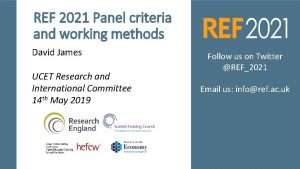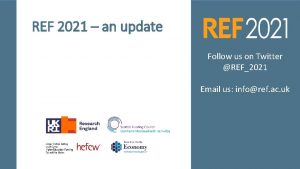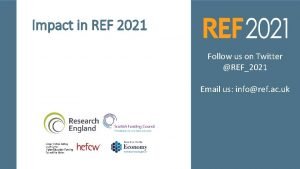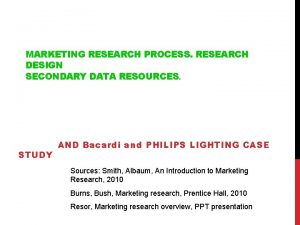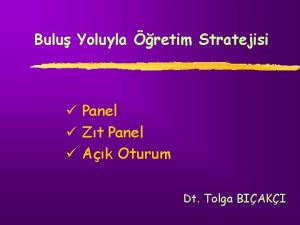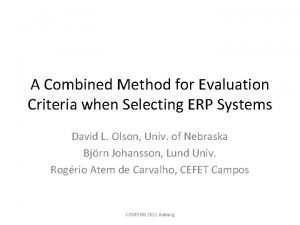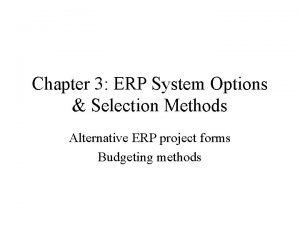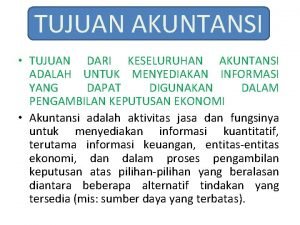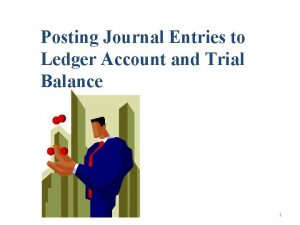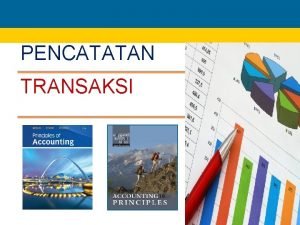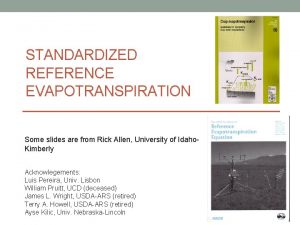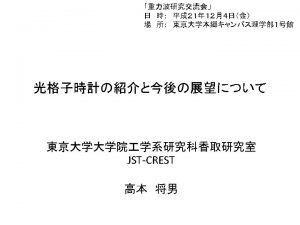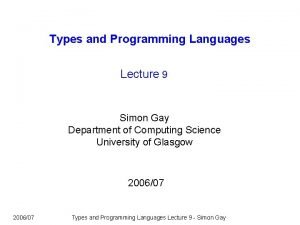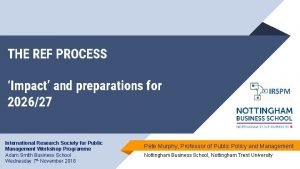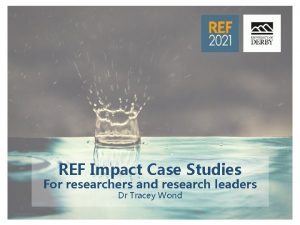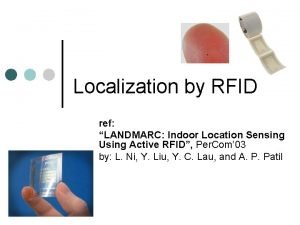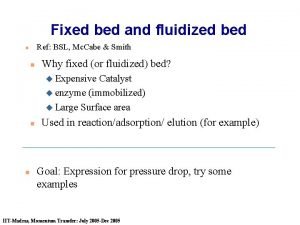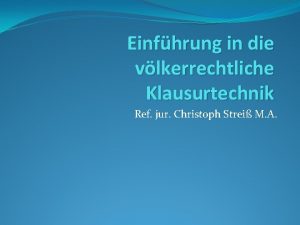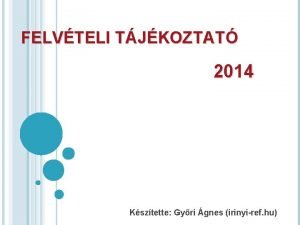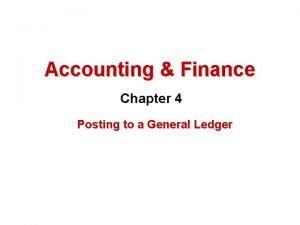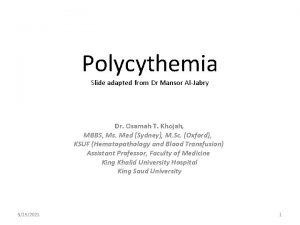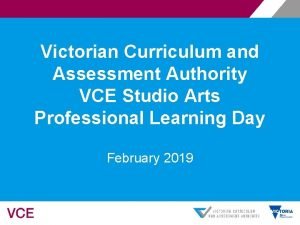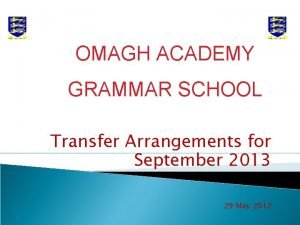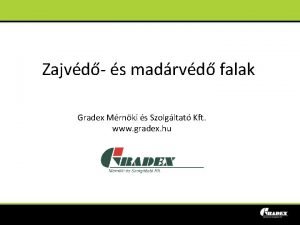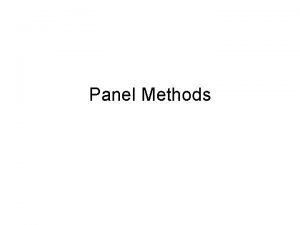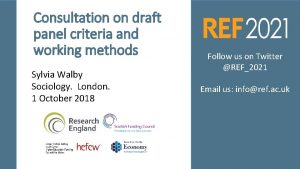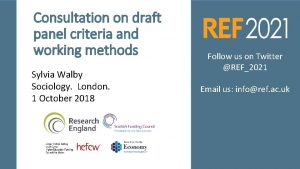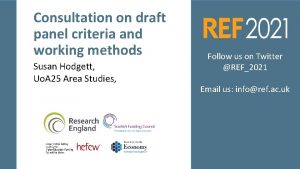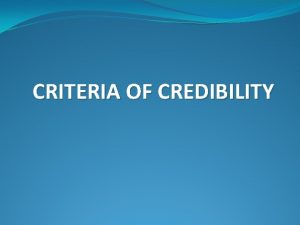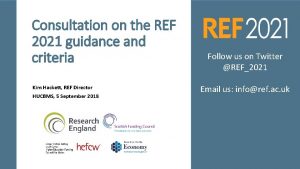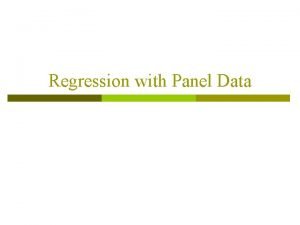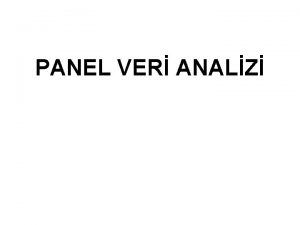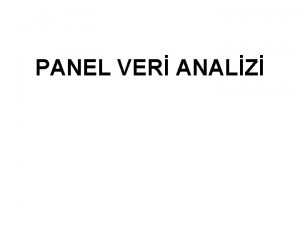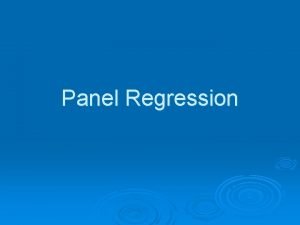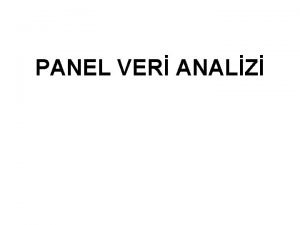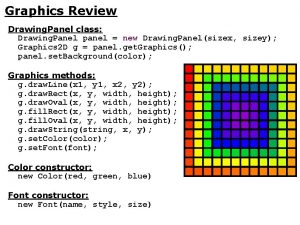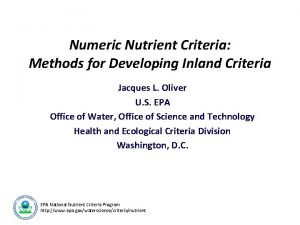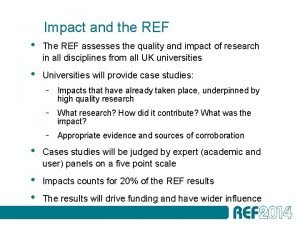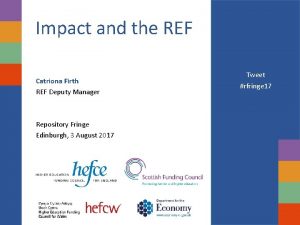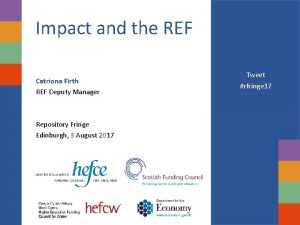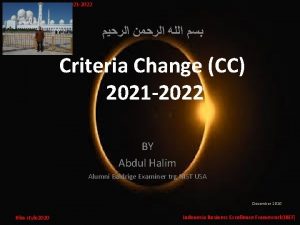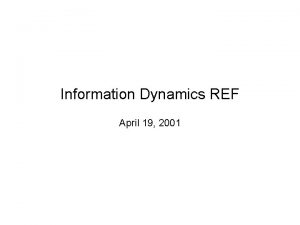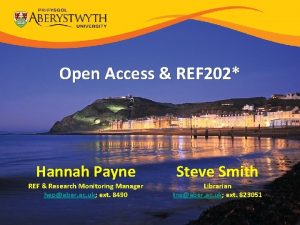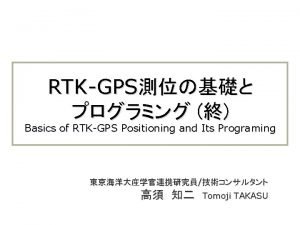REF 2021 Panel criteria and working methods David







































- Slides: 39

REF 2021 Panel criteria and working methods David James UCET Research and International Committee 14 th May 2019 Follow us on Twitter @REF_2021 Email us: info@ref. ac. uk

NOT THE TEF! (With apologies to Winston Churchill) Expert peer review is the worst possible system for assessing research quality, apart from all the others.


British Academy/Royal Society (2018) Harnessing educational research Adopts an ‘ecosystem’ perspective – flows of people, funding and information Notes a need for the teaching profession to be research-informed Offers eight recommendations to governments, UKRI and constituent bodies, universities, learned societies, regulators and professional bodies Finds that although two-thirds of education research was ‘world leading’ or ‘internationally excellent’ (REF 2014), there are ‘…disconnects between supply and demand’ Recommends an Office for Education Research (perhaps rather like the OSCHR)

Mills, Oancea & Robson (2017) The Capacity and Impact of Education Research in the UK Amongst other things, highlights the shape of the field: • Although ‘the total number of REF-eligible academic staff in Education in 2014 was 5255 FTE spread across 109 institutions…the total submitted to the REF exercise was 1442 in 76 submissions’. This = either 27% or 31% depending on the calculation used. • Submissions included between 3. 8 and 219 FTE. • Diversity of professional and academic experience…about one quarter of a sample of REF 2014 (education) research active staff had a background in teaching and/or held teaching qualifications. • Not all education research is done in Education departments/faculties

Education – submissions in REF 2014

2021 framework Overall quality Outputs Impact Environment FTE x 2. 5 = number of outputs required Impact case studies Environment data and template 60% 25% 15%

Expert panels • 34 sub-panels working under the guidance of four main panels with advice from Equality and Diversity and Interdisciplinary Research advisory panels (EDAP and IDAP) • Two-stage appointment process (via nominations): 1. Criteria-setting phase – sufficient members appointed to ensure each sub-panel has appropriate expertise 2. Assessment phase – recruitment in 2020 of additional panel members and assessors to ensure appropriate breadth of expertise and number of panel members necessary for the assessment phase, informed by the survey of institutions’ submission intentions in 2019.

Sub-panel appointments • So far, there are 18 people appointed to the Education sub-panel. It is very hard to predict, but possible that the membership will need to expand by 50 -100% • Remaining panel appointments in 2020 following the 2019 ‘survey of submission intentions’. • HE institutions not allowed to nominate possible panel members. Learned societies, professional associations and users of research can nominate. • So far, in respect of the Education Sub-panel, 158 nominations were made, pertaining to 127 distinct individuals. Of these, BERA nominated 42, UCET nominated 14. • Those already nominated are still ‘in the pool’. There will be an opportunity to make further nominations.

Interdisciplinary advisers • Interdisciplinary Research Advisory Panel • oversee application of agreed principles and processes • Main panel interdisciplinary leads • facilitate cross-panel liaison • oversee calibration exercise for IDR outputs • Sub-panel interdisciplinary advisers • At least two per sub-panel • Offer guidance to sub-panels on assessment of IDR outputs • Liaise with advisers on other panels

Expert panels Main panel responsibilities • Developing the panel criteria and working methods • Ensuring adherence to the criteria/procedures and consistent application of the overall assessment standards • Signing off the outcomes Sub-panel responsibilities • Contributing to the main panel criteria and working methods • Assessing submissions and recommending the outcomes

Consultation • • 294 respondents Views sought on clarity – broad agreement (70% +) across most areas Some areas showing well over 80% agreement Mixed views on key issues

Panel criteria Aims • build on REF 2014 criteria to create continuity • achieve consistency across the main panels, where possible, while taking into account disciplinary differences Structure • Unit of assessment (UOA) descriptors • Panel criteria (submissions, outputs, impact, environment) • Working methods

Key changes following consultation • • Research independence Staff in non UK-based units Co-authorship statements Submitting co-authored outputs more than once Version of output to be submitted Double weighting Continued impact case studies Increased focus on equality and diversity in environment

You may wish to focus on • Any of the ‘key changes’ just listed; • The ‘Descriptor’ of education research • Nominations and further panel appointments; • How the panel will work; • Myths and rumours; • Institutional experiences in the run-up to REF.

Independent researchers • ‘An individual who undertakes self-directed research, rather than carrying out another individual’s research programme’ • Research assistants / associates not normally eligible • GOS includes generic indicators, including: • Being named as principal investigator • Holding an independently won, competitively awarded fellowship where research independence is a requirement. (List at www. ref. ac. uk/guidance) • Leading a research group or a substantial or specialised work package.

Staff in non-UK based units • Staff employed by the UK HEI and based outside the UK will be eligible if the primary focus of their research activity on the census date is clearly and directly connected to the submitting unit based in the UK. • HEIs should use guidance on demonstrating a substantive connection to help determine whether they are eligible • Eligible staff should be returned to HESA. REF team is working with HESA to update their guidance.

Substantive connection • Statement required for staff on 0. 20 -0. 29 FTE • • evidence of participation in and contribution to the unit’s research environment evidence of wider involvement in the institution evidence of research activity focused in the institution period of time with the institution • Statement not required where particular personal and discipline-related circumstances apply

Outputs Assessed against three criteria: • Originality - the extent to which the output makes an important and innovative contribution to understanding and knowledge in the field • Significance - the extent to which the work has influenced, or has the capacity to influence, knowledge and scholarly thought, or the development and understanding of policy and/or practice • Rigour - the extent to which the work demonstrates intellectual coherence and integrity, and adopts robust and appropriate concepts, analyses, theories and methodologies Scored one to four star (or unclassified) • Each main panel sets out its own understanding of the starred quality levels

Outputs – interdisciplinary research • For the purposes of the REF, interdisciplinary research is understood to achieve outcomes (including new approaches) that could not be achieved within the framework of a single discipline. Interdisciplinary research features significant interaction between two or more disciplines and/or moves beyond established disciplinary foundations in applying or integrating research approaches from other disciplines. • HEIs are invited to identify outputs that meet this definition. This process is distinct from a request for cross-referral. • There will be no advantage or disadvantage in the assessment in identifying outputs as interdisciplinary. • No penalty for incorrectly identifying outputs as interdisciplinary (or not).

Outputs – co-authored • Institutions may only attribute co-authored outputs to individual members of staff who made a substantial research contribution to the output • Main Panel A: For each submitted co-authored output where there are fifteen or more authors and where the submitted member of staff is not identified as the lead or corresponding author, institutions are required to affirm the substantial contribution to the research by the submitted member of staff. • Sub-panel 9: for outputs with more than 15 co-authors and where the submitted member of staff is not identified as the lead or corresponding author, specific information is required about the author’s contribution (max. 100 words) • Main Panels C and D: not require the submission of information about the individual co-author’s contribution but may seek to verify via audit.

Outputs – co-authored • Consulted on whether HEIs should be able to submit an output more than once in a submission to a UOA • Mixed response from sector – suggested disciplinary differences might be justified • Main Panels A-C will not permit this • Main Panel D will permit submission up to two times. • Such outputs may make up max. 5% of submission. • Cannot be combined with double-weighting

Outputs – version • Proposed in draft guidance that HEIs submitting outputs of former staff must submit the version that was made publicly available when they were employed by that institution • Feedback from sector and consultation with panels revealed preference for submitting final version • Concerns that it is not always possible to identify the final version (e. g. for practice outputs) • HEIs can submit either version made available during employment or final version

Outputs – double-weighting • • • Alignment of criteria in Main Panels C and D All main panels will require a statement to accompany all double-weighting requests Removal of reference to the ‘disciplinary norm’ Expectation that most books will warrant double-weighting BUT this is not automatic Suggestion in consultation that HEIs should submit a ranked list of reserve outputs, rather than linking them to specific outputs. Panels agreed that this was unnecessarily complicated

Outputs – open access • Outputs deposited as soon after the point of acceptance as possible, and no later than three months after this date from 1 April 2018. • Deposit exception from 1 April 2018 – outputs remain compliant if they are deposited up to three months after the date of publication. • Additional flexibility – 5% tolerance band (or one output) per submission to a UOA

Impact Consistency with REF 2014 • Impact remains non-portable • 2* quality threshold • Timeframe: • 1 January 2000 - 31 December 2020 for underpinning research • 1 August 2013 - 31 July 2020 for impacts Refinements • Impact template integrated into Environment statement • Impact on teaching within (and beyond) own HEI is eligible • Enhanced clarity on scope of underpinning research – bodies of work • Guidance on submitting continued impact case studies • Enhanced guidance on public engagement

Impact – criteria Assessed against two criteria: • Reach (updated definition): Reach will be understood as the extent and/or diversity of the beneficiaries of the impact, as relevant to the nature of the impact. Reach will be assessed in terms of the extent to which the potential constituencies, number or groups of beneficiaries have been reached; it will not be assessed in purely geographic terms, nor in terms of absolute numbers of beneficiaries. The criteria will be applied wherever the impact occurred, regardless of geography or location, and whether in the UK or abroad • Significance - the degree to which the impact has enabled, enriched, influenced, informed or changed the performance, policies, practices, products, services, understanding, awareness or wellbeing of the beneficiaries.

Impact – continued case studies • Case studies continued from examples submitted to REF 2014 are eligible • Must meet the same eligibility criteria, including the length of the window for underpinning research (1 January 2000 to 31 December 2020) and the assessment period (1 August 2013 to 31 July 2020) for the impact described

Impact – types and indicators • Panels welcome case studies that describe any type(s) of impact • Panel will welcome, and assess equitably, case studies describing impacts achieved through public engagement, either as the main impact described or as one facet of a wider range of impacts. • Impact on teaching within (and beyond) own HEI is eligible • Case studies must provide a clear and coherent narrative supported by verifiable evidence and indicators • Should provide evidence of reach and significance of the impacts, as distinct from evidence of dissemination or uptake • Annex A includes an extensive – but not exhaustive – list of examples of impact and indicators, including evaluation frameworks from non-HE organisations

Impact – underpinning research • Panels recognise that the relationship between research and impact can be indirect and non-linear • Underpinning research as a whole must be min. 2* quality • Case studies must include up to six key references (not every output referenced has to be 2*) – HEIs can consult the outputs glossary in the Guidance on submissions • Can also include indicators of quality e. g. evidence of peer-reviewed funding, prizes or awards for individual outputs etc. • May be a body of work produced over a number of years or may be the output(s) of a particular project • Must be produced by someone working at the HEI within the scope of the UOA descriptor • Does not need to be a Category A eligible staff member • Impact case study can be returned to different UOA from the outputs that underpin it

Environment Assessment criteria: • Vitality - the extent to which a unit supports a thriving and inclusive research culture for all staff and research students, that is based on a clearly articulated strategy for research and enabling its impact, is engaged with the national and international research and user communities and is able to attract excellent postgraduate and postdoctoral researchers. • Sustainability - the extent to which the research environment ensures the future health, diversity, well-being and wider contribution of the unit and the discipline(s), including investment in people and in infrastructure.

Environment template Sections a. Unit context, research and impact strategy. b. People, including: a. staffing strategy and staff development b. research students c. equality and diversity. c. Income, infrastructure and facilities. d. Collaboration and contribution to the research base, economy and society. Information from 2014 impact template to be included across the four sections Increased emphasis on equality and diversity (not limited to ‘People’)

Environment template Weighting • Main Panel A, B and C will attach equal weighting to each of the four sections • Recognising the primary role that people play as the key resource in the arts and humanities, Main Panel D will attach differential weight to sections: • • Unit context and structure, research and impact strategy (25%) People (30%) Income, infrastructure and facilities (20%) Collaboration and contribution to the research base, economy and society (25%)

Institutional level assessment of environment • Institutional-level information will be appended to the UOA-level environment template and will be taken into account by the sub-panel when assessing the unit-level statement. • Pilot of the standalone assessment of the discrete institutional-level environment will draw on this submitted information. • Outcomes from the separate pilot exercise will not be included in REF 2021 but will inform future research assessment. • Increase in word limit to min. 4, 000 words. • Further guidance and criteria to be published in summer 2019 following consultation.

Timetable Spring/summer 2019 Submission deadline for codes of practice: 7 June 2019 Invitation to request multiple submissions, case studies requiring security clearance, and exceptions to submission for small units Launch beta version of submission system Autumn 2019 Pilot of the REF submission system; Survey of submissions intentions opens; Invitation to submit reduction requests for staff circumstances December 2019 Survey of submissions intentions complete Final deadline for requests for multiple submissions, case studies requiring security clearance, and exceptions to submission for small units Publication of approved codes of practice Early/mid 2020 Formal release of the submission systems and technical guidance Invitation to HEIs to make submissions Appointment of panel members & assessors for assessment phase Deadline for staff circumstances requests 31 July 2020 Census date for staff End of assessment period (for impact, environment, and data about research income and research doctoral degrees awarded) 27 November 2020 Closing date for submissions

Some key elements of sub-panel process • Calibration • Allocation • Assessment • Moderation • Collective responsibility • International comparison • Avoiding conflicts of interest

Educationalists note: our discipline has the conceptual tools to understand REF • REF is a process of FRESH peer review • The definition of research and the quality criteria are both written down, but there are limits to such codification (Cf. Eraut, or Sennett) and anyway, their meaning is a matter of negotiation, participation and reification in a community of practice (to use Lave and Wenger’s terms) • Parallels with well-known work on HE assessment (e. g. Sadler, or Boud, and many others) – judgement of quality is always more than the rigid application of well-defined criteria. Connoisseurship too.

Very good things to remember • There is both a generic REF definition of research AND an Education Sub-panel descriptor of Educational Research. The latter is broad. Both are important. • Institutional processes for estimating the quality of research outputs are often a poor proxy what happens in REF. • It’s not meant to be about you. The serious intention of REF is to measure the quality of research in institutions – NOT that of individuals per se. Hence ‘decoupling’. • The panel will have been chosen carefully to reflect the substantive, methodological and epistemological breadth of the field and expected submissions. They will also all have relevant experience. • They will be of the field, AND will work in a collegial manner for the field.

Further information • www. ref. ac. uk (includes all relevant documents and FAQs) • Enquiries from staff at HEIs should be directed to their nominated institutional contact (available at www. ref. ac. uk/contact) • Other enquiries to info@ref. ac. uk
 Ref criteria
Ref criteria Ref 2021 twitter
Ref 2021 twitter Twitter ref 2021
Twitter ref 2021 Continuous panel vs discontinuous panel
Continuous panel vs discontinuous panel Zıt panel nedir
Zıt panel nedir Hot working and cold working difference
Hot working and cold working difference Advantages of cold working
Advantages of cold working Differentiate between hot working and cold working
Differentiate between hot working and cold working Proses hot working
Proses hot working Erp selection criteria matrix
Erp selection criteria matrix Erp system options and selection methods
Erp system options and selection methods Smart work vs hard work
Smart work vs hard work Laporan perubahan modal
Laporan perubahan modal Posting in accounting
Posting in accounting Debit kredit akuntansi
Debit kredit akuntansi Usa hockey penalty signals
Usa hockey penalty signals 3 man system hockey linesman
3 man system hockey linesman Usa hockey ref signals
Usa hockey ref signals Ref et idaho
Ref et idaho Ref kirche rothrist
Ref kirche rothrist Packages_display.php?ref=
Packages_display.php?ref= Volleyball ref stand
Volleyball ref stand Reference divider
Reference divider X ref
X ref Ref 2026
Ref 2026 X ref
X ref Ref impact case studies
Ref impact case studies Ref
Ref Ergun equation
Ergun equation Ref jur
Ref jur Ref-qualified member functions
Ref-qualified member functions Felvi középiskolai bizonyítvány feltöltése
Felvi középiskolai bizonyítvány feltöltése Post. ref. accounting
Post. ref. accounting Polycythemia vera diagnostic criteria 2021
Polycythemia vera diagnostic criteria 2021 Studio art evaluation
Studio art evaluation Drug regimen unassisted grading scale
Drug regimen unassisted grading scale Omagh academy admissions criteria 2021
Omagh academy admissions criteria 2021 Wax pattern fabrication
Wax pattern fabrication How do you save panel locations and visibility preferences?
How do you save panel locations and visibility preferences? Zajvédő panel
Zajvédő panel
